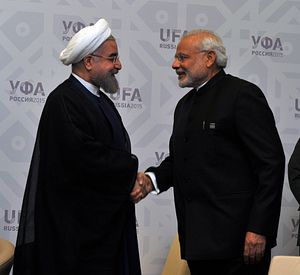Ever since Iran and international powers inked a nuclear deal, India has been vigorously debating the meaning of the agreement for South Asia. The Diplomat’s Sanjay Kumar spoke to Sujata Ashwarya Cheema, an India-based professor of West Asian Studies, to understand the implication of the deal on India in particular and South Asia in general.
The Diplomat: How do you look at the Iran deal?
Sujata Ashwarya Cheema: Considering the decades of animosity between Iran and the United States and deep-seated suspicion between Tehran and the West in general, the deal reached in Vienna after 18 months of tough diplomatic negotiations is a major breakthrough.
The alternative to the deal would have been no deal, which would have meant further destabilization of an already troubled region.
More importantly, the agreement gives the Islamic Republic an unprecedented opportunity to restructure its economy and leverage its newfound situation to confront challenges of violent extremism in the Middle East. It also gives the United States space and time to fashion a new balance of power in the region, thereby creating a new geopolitical order in the Middle East, post-Iraq withdrawal.
What implication it will have in South Asia?
The Vienna deal opens up possibilities for cooperation between erstwhile enemies, the United States and Iran. As far as South Asia is concerned, the biggest possibility of Iran-U.S. engagement I see is in Afghanistan. So far they have not cooperated in stabilizing the war torn country. With the deal, Washington could open a new route to reach Afghanistan through Tehran, both materially and metaphorically. That will reduce the United States’ dependence on the treacherous route through Pakistan.
So far, the West has been averse to any kind of “regional solution” to the Afghan imbroglio but now that reservation will not hold ground. In the context of the changing dynamics between Washington and Tehran, the possibility of Iran becoming a key ally of the West in its search for an Afghan solution cannot be ruled out.
It is no secret that Tehran is also engaging the Taliban and meeting different delegates. Such meetings may eventually get Western legitimization and give a boost to peace talks with the insurgents in Afghanistan. The Taliban has held a preliminary round of talks in Pakistan with the Afghan government; the possibility of Iranian mediation cannot be considered too far-fetched. In addition, the Islamic Republic will be a trustworthy ally in its fight against the nascent Islamic State in Afghanistan.
What does India stand to gain (and lose) after the deal?
India shares a deep civilizational bond with Iran and is, therefore, a special friend. In recent times, however, under the pressure from Washington, it voted against Iran at the IAEA and implemented trade and oil sanctions.
But New Delhi’s engagement with Tehran has been increasing; it increased its oil imports from Iran by over 50 percent in April this year from the same period last year, thereby giving an early indication that New Delhi is keen to expand its economic engagement with the Persian Gulf country.
With the lifting of sanctions, Iran will be looking for investments and an expansion of trade. Facing energy sanctions, Iran was keen to have Indian upstream investment in its oil and gas development sectors. However, once the sanctions regime is dismantled, technologically advanced Western countries will be in the fray and India might lose out in this lucrative sector. Let’s wait and watch. India’s exports to Iran are also likely to face stiff competition for other players in the market, once the sanctions are relaxed.
The Chabahar port and the International North South Trade Corridor (INSTC), India’s showpiece connectivity projects in Iran, will get a new lease on life. India will now be able to make investments and agreements without the fear of contravening sanctions. The two projects are extremely important for India, as they will provide sea-land access to Afghanistan and Central Asia, circumventing Pakistan. Once the port is developed and the INSTC comes into full operation, the whole political and economic dynamics of the region will tilt in India’s favor. India must expedite the development of the Chabahar port, where it committed about $85 million last year.
Both countries were partners in Afghanistan in the 1990s. The nuclear deal can give a new dynamism to the camaraderie in the landlocked country. New Delhi is feeling isolated in Afghanistan with the emergence of a new axis, comprised of Afghanistan, China, and Pakistan. Iran offers a new possibility for New Delhi to have a role in the development and stabilization of Afghanistan.
Given the growing proximity of New Delhi with Saudi Arabia and Israel, how easy or difficult it would be for India to develop ties with Tehran?
India’s current engagement with West Asia weighs heavily in favor of the Arab Gulf states and Israel. With more than 4 million of its citizens in the workforce of the Gulf States and robust defense and technological cooperation with Israel, India may feel constrained vis-à-vis enhancing ties with Iran in the extant regional equation. Needless to say, New Delhi will have to tread cautiously and delicately. India’s fine balancing act and ‘strategic autonomy’ will have to be put to good use in balancing these trends and safeguarding vital national interests.
India will have to watch the emerging equation between Riyadh and Islamabad. If Saudi Arabia feels threatened by the rapprochement between Iran and the West, it might try to acquire nuclear weapons from Pakistan. A covert understanding between the two states on nuclear assistance is not the best-guarded secret.
India’s diplomacy and outreach in the region may face its severest test in the coming days.

































